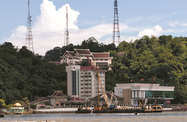Infrastructure was a major beneficiary in Brunei Darussalam’s budget for FY 2016/17, alongside other key segments of the economy expected to steer the country toward more robust growth.
Weaker performances in the hydrocarbons and services sectors dampened the Sultanate’s economic performance in the final quarter of 2015, leaving growth in negative territory at the end of what proved to be a challenging year.
However, prospects for 2016 look brighter, with consumer confidence already on the rise, supported by a healthy pipeline of projects.
Better than expected
Brunei Darussalam’s GDP shrank by about 0.6% in constant prices in 2015, according to data issued by the Department of Economic Development and Planning, driven down primarily by lower returns from the oil and gas sector.
Upstream energy’s contribution to GDP fell by 1.2% to BN$8.44bn ($6.3bn) in 2015, though the drop was more significant when measured in current prices, declining by more than 27% over the period. Earnings from downstream production also slipped, albeit more modestly.
Nonetheless, the contraction in economic output was more measured than many international financial institutions (IFIs) had predicted. In March of last year the Asian Development Bank (ADB) said it expected the economy to shrink by 1.5%, while the IMF forecast a 1.2% contraction as recently as October.
The full-year results also demonstrate a solid improvement over the previous two years, when Brunei Darussalam’s economy shrank by 2.3% (2014) and 1.8% (2013).
Non-oil growth
Losses were offset by gains in other sectors, including the agriculture, fisheries and forestry industry, which ended the year up 6.4%. The fisheries segment led growth, expanding by 19.1%, while the vegetables, fruits and remaining agricultural component rose by 9.7%.
Brunei Darussalam’s economy also received a boost from household expenditure, which rose by 4.2% year-on-year in the fourth quarter, following a 2.8% increase the previous quarter.
If consumer confidence and spending power improves further in 2016, this could spur higher levels of growth in key sectors, notably retail and real estate.
Budget boost
Looking ahead, Brunei Darussalam aims to leverage its FY 2016/17 budget of BN$5.6bn ($4.2bn), which came into force on April 1, to stimulate the economy.
Infrastructure development was one of the budget’s winners, with BN$523.6m ($390.1m) allocated for a broad range of projects. Other engines of growth, such as forestry, fisheries, agriculture and agri-foods, also fared well, receiving a combined BN$46.6m ($34.7m) in funding.
Despite a 1.78% reduction in overall fiscal spending, however, the raft of new infrastructure projects could add to the budget deficit. Government projections put public revenue at BN$1.76bn ($1.3bn) for FY 2016/17, which could drive the deficit up from an estimated BN$2.28bn ($1.7bn) in FY 2015/16 to BN$3.84bn ($2.9bn), according to local media.
Improved outlook
Nonetheless, Brunei Darussalam’s fiscal prospects are looking increasingly positive. From a low of $28 per barrel in January, Brent crude has risen to close to $45 as of mid-April, with analysts at Credit Suisse suggesting prices could rebound to $50 by May on resurgent demand in the US, India, South Korea and China. If this trend continues, Brunei Darussalam could see increased revenue flows for by the second half of 2016.
Some IFIs have been similarly upbeat about the Sultanate’s economic prospects.
In late March the ADB said it expected Brunei Darussalam’s economy to post positive growth in 2016 on the back of higher energy prices and increased production from existing fields thanks to the deployment of new extraction technology.
Provided global oil demand and prices continue their recovery, Brunei Darussalam’s GDP should increase by 1% this year, rising to 2.5% in 2017.
The OECD, meanwhile, said in late 2015 that it expects Brunei Darussalam to average GDP growth of 1.8% per annum through to 2020 – lower than the forecasts for its ASEAN counterparts but sufficient to signal something of a turnaround after three challenging years.
The ADB added that growth would be supported by higher levels of activity in the construction sector, particularly large-scale infrastructure projects like the BN$138.9m ($103.5m) Sungai Brunei Bridge.
The bank also urged Brunei Darussalam to use the period of lower energy prices to reduce subsidies on both fuel and electricity without burdening consumers with steep increases in tariffs. Importantly, this would free up more resources for both physical and social infrastructure development, spurring further non-oil growth.
Oxford Business Group is now on Instagram. Follow us here for news and stunning imagery from the more than 30 markets we cover.

